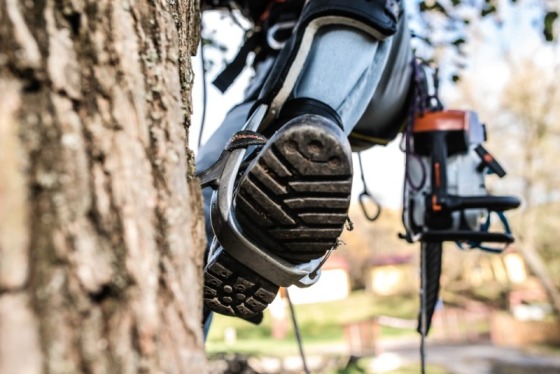
Cabling and Staking Trees: What You Need to Know

Why Should A Tree Be Cabled?
A tree should be cabled if it has two trunks, limbs are growing into each other, has over extended limbs that that are very long or branches are growing downward or horizontally.
Cabling reduces the chance that a tree will break apart and need to be removed. Ultimately the tree will live longer.
How Is Cabling Done?
The most common form of cabling is the installation of lags with thimbles that are attached to each limb or lead. A steel cable is then attached around the thimbles to absorb motion so the tree has natural movement and the cable doesn’t wear out causing it to break. There are other materials and systems that may be better suited for a particular tree or situation. One of our certified arborists can help you determine the best course of action.
Cabling should always be done by an ISA certified arborist and experienced climber. If installed incorrectly it can cause do damage to the tree and ultimately the tree may be lost. Inexperienced tree companies have been known to wrap cables around the trunk instead of using lags and thimbles. When the tree starts to grow and expand the cables around the trunk or large start to choke of the sap line this causes stress to the tree leading to a myriad of problems.
What is Staking?
Most commonly staking is done to young trees for the purpose of stabilization. However there are some instances a mature tree would benefit from staking. The best method and material is different for each tree. Deciding the method depends on size, tree type and the planting process.
Common Staking Methods
Single Staking – is used for bare root trees and is done before planting. The anchor is 1/3 the height of the tree. This anchors the roots but allows the stem to sway and thicken.
Double Staking – is the standard method. Two or three stakes are inserted opposite of each other or equally spaced around the tree on the outside of the root ball using long ties or timber crossbar. This method is very effective for trees exposed to strong winds.
Angle Staking – When a tree is planted on a slope a stake is driven in at a 45 degree angle leaning into the prevailing wind and secured with a flexible tie.
Guying – this is particularly good when used for large transplanted or weather damaged trees. We use a strong wire and attach it to low stakes or anchors inserted at a 45 degree angle going away from the tree using guy-lines and ground anchors. We always flag the guy lines they are a trip hazard.
Stakes should always penetrate the ground by two or more feet allowing to properly anchor. Stakes are made from wood or metal. They are only used for a year otherwise they can strangle the trees sap line. Trees will become dependent on the stake. The wood on the tree may become weaker and undermine the natural tapering of the tree. In the end, when the anchors are removed the tree should thrive on its own.
If it is an emergency please call us immediately at 703-354-3667.
Use this form to schedule a FREE estimate. After submitting your form, our team will contact you to set up this appointment.
